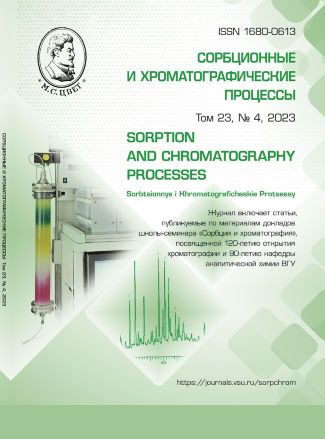Equilibrium of sorption of Tribulus Terrestris steroid saponins on a natural polymer sorbent – chitosan
Abstract
Steroidal saponins have a wide spectrum of pharmacological action and therefore are widely used in pharmacological practice. Chitosan is a unique material. Its biocompatibility, biodegradability, non-toxicity, as well as its cationic nature reveal the potential of this biopolymer as a carrier of drugs for their targeted delivery. The immobilization of biologically active substances can be carried out in a variety of ways - nanomicelles with an encapsulated drug or their polyelectrolyte complexes with oligochitosans, depending on the nature of the active substance. The study of the sorption of saponins by chitosan under equilibrium conditions was studied. An analysis of the equilibrium curves of sorption of Tribulus Terrestris saponin on chitosan was carried out. The presence of a local minimum on the isotherm in the region of solution concentrations corresponding to micellization was revealed. It has been established that the course of the saponin sorption isotherm is determined by competing association processes in a solution and on the surface of chitosan. The pH of the solution did not change, which indicated the absence of ionic interactions involving the protonated amino group of chitosan. The moisture content of chitosan during the sorption of saponin was studied. The antibatic nature of the absorption curves and moisture content curves of chitosan was revealed. An analysis of the saponin sorption isotherm was carried out using the adsorption theories of Langmuir, Freundlich, and BET. High values of the correlation coefficients allowed us to use the Freundlich equation for a quantitative description of the isotherm in the initial section, and to analyse the entire isotherm using the BET theory, which takes into account the polymolecular nature of sorption. The results obtained for the description of the sorption isotherm of saponin were consistent with the proposed mechanism of its absorption by chitosan.
Using IR spectroscopy, it was established that the interaction in the sorbent-sorbate system was due to the emerging hydrogen bonds between the amino and hydroxyl groups of chitosan and the hydroxyl groups of saponin carbohydrates. The results obtained, as well as literature data, confirm the formation of cavities in polysaccharides into which saponin is “incorporated”. In our case, the presence of cavities formed by seven monomer fragments of chitosan, the stability of which is fixed by hydrogen bonds was discussed.
Downloads
References
Jiang Yulin, Massiot Georges, Lavaud Catherine, Teulon Jean-Marie, Guechot Christophe, Haag-Berrurier Micheline, An-ton Robert Triterpenoid glycosides from the bark of Mimosa tenuiflora. Phytochem-istry. 1991; 30(7): 2357-2360. https://doi.org/10.1016/0031-9422(91)83648-5
Roner M., Sprayberry J., Spinks M., Dhanji S. Antiviral activity obtained from aqueous extracts of the Chilean soapbark tree (Quillaja saponaria Molina). Journal of General Virology. 2007; 88: 275-285. https://doi.org/10.1099/vir.0.82321-0
Kuznecov V.A. Slivkin A.I., Lapenko V.L., Bolgov A.A. Hitozan i dezoksikrah-mal v kachestve polimernyh matric dlja immobilizacii biologicheski aktivnyh komponentov. Vestnik MITHT. 2009; 3: 97-102. (In Russ.)
Rinaudo M., Kil’deeva N. R., Babak V. G. Surfactant-polyelectrolyte complexes on the basis of chitin. Russian Journal of General Chemistry. 2008; 78: 2239-2246.
Kovalenko G.A., Kuznecova E.V. Ad-sorbcija antiseptikov (furacilina, hlor-geksidina) i vitamina E na uglerod-soderzhashhih jenterosorbentah. Himiko-farmacevticheskij zhurnal. 2000; 34(6): 45-49. (In Russ.)
Mironenko N.V., Smuseva S.O., Brezhneva T.A., Selemenev V.F. Kinetich-eskie i ravnovesnye harakteristiki sorbcii saponina Quillaja Saponaria Molina na hitozane. Zhurnal fizicheskoj himii. 2016; 90(12): 1870-1875. (In Russ.)
Mironenko N.V., Brezhneva T.A, Sel-emenev V.F., Stolpovskaja A.A. UF-spektrofotometricheskoe opredelenie triterpenovyh saponinov Quillaja Sapona-ria Molina. Vestnik Voronezh. gos. un-ta. Serija: Himija. Biologija. Farmacija. 2015; 1: 16-21. (In Russ.)
Nakanisi K. Infrakrasnye spektry i stroenie organicheskih soedinenij, M., Mir, 1965, 216 p. (In Russ.)
Kazicyna L.Α., Kupletskaja N.B. Primenenie UF-, IK-, JaMR- i mass-spektroskopii v organicheskoj himii, M., Izd-vo Mosk. un-ta, 1979, 240 p. (In Russ.)
Selemenev V.F., Slavinskaja G.V., Hohlov V.Ju., Chikin G.A. Praktikum po ionnomu obmenu. Voronezh: Izd-vo Voro-nezh. un-ta, 1999, 173 p. (In Russ.)
Smuseva S.O., Mironenko N.V., Brezhneva T.A., Selemenev V.F., Grech-kina M.V. Sorbcija saponina Quillaja sa-ponaria Molina hitozanom v ravnovesnyh uslovijah. Zhurnal obshhej himii. 2017; 87(8): 1367-1373. (In Russ.)
Hohlov A.R., Dormidontova E.E. Samoorganizacija v ion-soderzhashhih polimernyh sistemah. Uspehi fizicheskih nauk. 1997; 167(2): 113-128. (In Russ.)
Mironenko N.V., Shkutina I.V., Sel-emenev V.F. Osobennosti micelloobra-zovanija pentaciklicheskih glikozidov v vodnyh rastvorah. Izvestija vuzov. Himija i himicheskaja tehnologija. 2021; 64(4): 26-33. (In Russ.)
Koganovskij A.M., Klimenko N.A. Fiziko-himicheskie osnovy izvlechenija poverhnostno-aktivnyh veshhestv iz vod-nyh rastvorov i stochnyh vod. Kiev, Nau-kova dumka, 1978, 174 p. (In Russ.)
Koganovskij A.M., Klimenko N.A. Adsorbcija organicheskih veshhestv iz vody. L., Himija, 1990, 256 p. (In Russ.)
Parfit G., Rochester K. Adsorbcija iz rastvorov na poverhnostjah tverdyh tel. M., Mir, 1986, 488 p.
Plisko E A., Nul'ga L.A., Danilov S.N. Hitin i ego himicheskie prevrashheni-ja. Uspehi himii. 1997; 46(8): 1470-1487. https://doi.org/10.1070/RC1977v046n08ABEH002171 (In Russ.)
Ioshhenko Ju.P., Kondruckij D.A., Kablov V.F. Poluchenie i svojstva polimo-lekuljarnyh kompleksov hitozana s biora-zlagaemymi polimerami. Vestnik MITHT. 2006; 5: 49-53. (In Russ.)
Selemenev V.F., Rudakov O.B., Ko-tova D.L., Eliseeva T.V. Mezhmoleku-ljarnye vzaimodejstvija i obrazovanie pere-syshhennyh rastvorov aminokislot v faze vysokoosnovnogo anionite. V kn. «Nasledie M.S. Cveta v trudah voronezh-skih himikov». Vol. 1. Voronezh, Nauchna-ja kniga, 2021: 89-131. (In Russ.)
Sveshnikova D.A., Kunzhueva K.G., Ataev D.R. Sorbcija ionov rubidija iz vod-nyh rastvorov aktivirovannymi ugljami. Sorbtsionnye i khromatograficheskie protsessy. 2012; 12(3): 270-279. (In Russ.)
Sveshnikova D.A., Hamizov R.H., Ataev M.B., Amirov A.M., Rabadanov K.Sh., Ramazanov A.Sh. Issledovanie za-konomernostej jelektrosorbcii ionov cezija aktivirovannym uglem DAK. Sorbtsionnye i khromatograficheskie protsessy. 2016; 16(3): 270-280. (In Russ.)
Freundlich H.M.F. Over the adsorption in solution. J. Phys. Chem. 1906; 57: 385-471.
Mironenko N.V., Smuseva S.O., Brezhneva T.A., Selemenev V.F., Nechae-va L.S. Komp'juternoe modelirovanie vzaimodejstvija triterpenovyh glikozidov s prirodnym polimerom – hitozanom. Zhur-nal obshhej himii. 2017; 87(8): 1367-1373. (In Russ.)
Zavodinskij V.G., Gnidenko A.A., Davydova V.N., Ermak I.M. Kvantovo-mehanicheskie metody issledovanija nano-razmernyh system. Butlerovskie soob-shhenija. Podrazdel: Kvantovaja himija. Himija i komp'juternoe modelirovanie. 2003; 2: 11-21. (In Russ.)
Hitin i hitozan: poluchenie, svojstva i primenenie / Pod red. K.G.Skrjabina, G.A. Vihorevoj, V.P. Varlamova. M., Nauka, 2002, 368 p. (In Russ.)
Bochkov A.F., Afanas'ev V.A., Zai-kov G.E. Obrazovanie i rasshheplenie glikozidnyh svjazej, M., Nauka., 1978, 180 p. (In Russ.)







